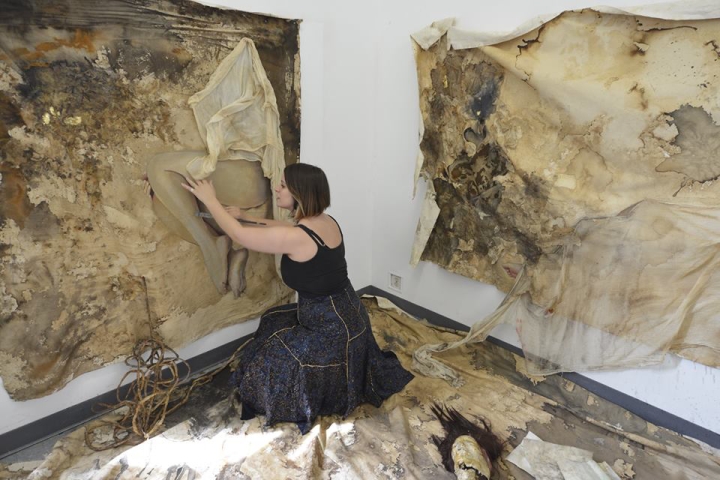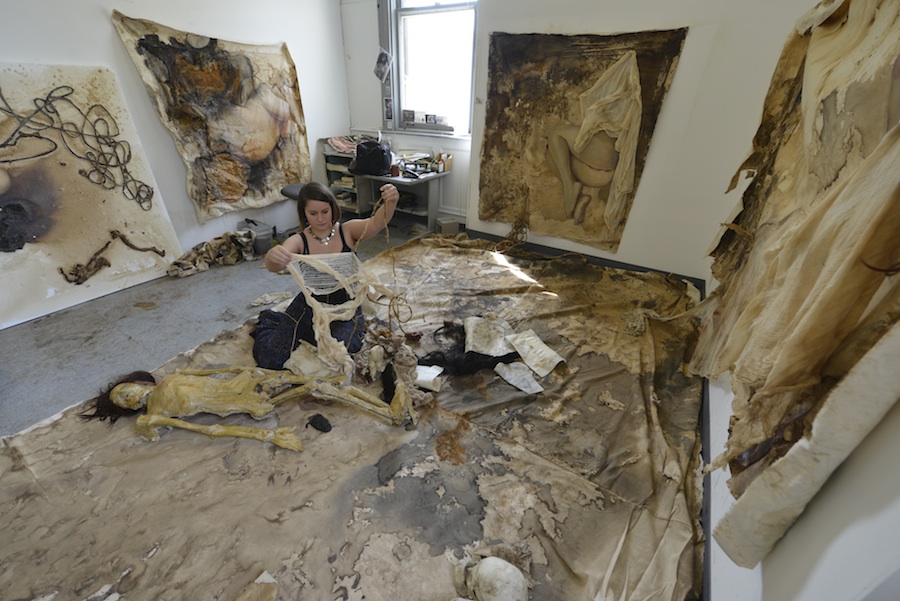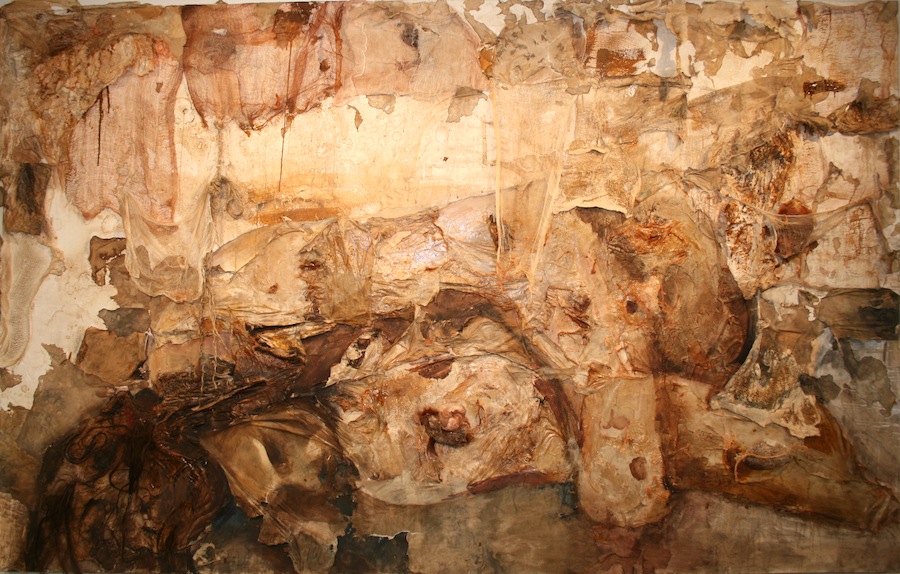
Artist to Watch: Christy Kirk
Artist to Watch: Christy Kirk received her Master of Fine Arts from Washington University in 2014. She has also received her Bachelors of Fine Arts from University of North Carolina at Asheville and an Associates from Central Piedmont Community College. Her primary subject is the human form and condition depicted through a variety of media including painting, drawing, and sculpture. She currently resides in Asheville, North Carolina and is awesome.
Phillip: Thank you Christy, for taking the time out to do this interview with me. I’ve been a fan of your work from the time we met at Washington University in St. Louis and would love to dig deeper into your craft, what keeps you motivated, and where you see yourself in the future.
Let’s start from the beginning. How did you get into art and what mediums were your focal point in the beginning?
Christy: Thank you for asking me! I’m grateful for the opportunity and flattered that you are interested in my work.
I was first introduced to fine art as a child when my mother would take me to museums. I remember being shocked by the nudes and she would explain that it was art. Like everyone else, I started making art in kindergarten. I was obsessive about accurately depicting what I saw and that drove me to sharpen my rendering skills. I started drawing with pencils mostly and eventually painting for the first time in 2008 in community college.
P: Was it in community college where you discovered that this would be a passion of yours? Can you talk about the transition between 2008 and entering into grad school in 2012?
C: No. I had decided in high school that I would get my degree in art. My community college allowed a smooth transition from high school to a University. In community college, I took figure drawing and for the first time ever I drew the nude figure. It was then that I knew I never wanted to depict anything else again. I fell in love with the human form.
When I transferred to University of North Carolina at Asheville, I started painting the human figure more using larger canvas to do so. My senior exhibition depicted of large scale, colorful portraits (4’ x 4’ – 6’ x 4’) in the context of technology. I wanted to paint the vacant facial expressions of those caught in the trance of technological devices (eg. phones, computers, t.v.s). I used these images in my portfolio for grad school.
P: And then you moved from creating those images to really looking at the human body in all of its beauty, even when that beauty seems sourced from decay/destruction. At least, that is my take on it haha. What changed when you got into grad school as you found yourself with time and space to create and deadlines to meet?
“When I got to grad school I felt the need to reinvent myself and my work.” Christy
C: I had been obsessively depicting and rendering from the photograph for so long and I needed a break. I took a papermaking class and started working intuitively rather than illustrating concepts I had. In the first semester the professors were really understanding and encouraged experimentation. I casted paper skulls and hung gauze that I had dipped in different dyes on the wall. I felt like I had no idea what I was doing but I loved the skulls and I loved the freedom to experiment. I also discovered a way of working abstractly, referencing the body and its parts without accurately depicting them. This lead to some grotesque little creations. Coffee also became a new material I discovered in this time. I would go to Starbucks and collect their expired coffee and pour it all over the canvas on the floor. This aged my work and also created a blood splattering effect that I loved.
P: I think people feel as though artists have a definite goal or set of goals when creating art. It’s the idea that the vision comes all at once and whole. You mention experimentation and I wonder how much of what art is depends on being lost, of not having a definite idea of where to start but allowing yourself to just go, create, and see what happens. Could you speak to that idea of vision versus discovery?

C: As far as the intention of concept, my own experience of this is minimal. In art education you first learn how to draw not why you draw. You first learn to recreate what you see, mindlessly and without intention. It was a difficult transition – for me at least- to make art that meant something and wasn’t just aesthetically pleasing. I sometimes will get an idea of something I feel I should paint or draw and then go and chase that vision down but I fear this leads to just illustrating and allows no room for the viewer to decipher the meaning. This is how I thought all art was created. You have something you want to say to the world and then you say it through your art. Recently, through my experimenting, I have learned that I could work backwards. I could first create intuitively and then discover a concept within that work. I found that this way of working forced me to dig through my own subconscious ideals and also allows the viewer to do the same for themselves.
P: What have you discovered, via creating art intuitively, were some of your obsessions? What has your own art taught you about yourself as a person, perhaps even as a citizen of the world?
C: The work I made in grad school and the last few years have been the most powerful and visceral work I’ve created yet. I started out creating paper skulls (which I love aesthetically and symbolically) and I would hang them on the wall. It appeared archeological and morbid. After awhile I began to miss painting so I took these newfound materials and started applying them to the canvas, layering more textures. I was obsessed with textures and materials. I eventually created through this Her Cathartic Decay which is a figure buried in textures of latex, hair, gauze, and paper. As my professors began to push for a deeper explanation than just the comparison of attraction and repulsion. I began to look deeper inside myself for answers. I discovered that it was a sort of autobiographical piece of a past trauma. After that I wanted to continue exploring human traumas and experience through my work. It was important to me to create healing through the abjection of these dark experiences.
P: And the results are stunning. What I loved most about your work was how realistic the bodies looked. Everything from hair to skin texture to color (browns bleeding into rust into gold into cream). That touched me very much, how precise your eye was to human anatomy.
After creating a piece and knowing it is “finished”, what happens next? I’m thinking about how you might get a piece into a gallery space or sell a work of art. Are these the next steps? How important do these two particulars figure into what you do?
“After finishing a piece my next step is to BURN IT. Then I take the ashes and mail them to galleries. Just kidding.” Christy
C: I usually post pictures on my facebook of a finished work. Then it sits around in my apartment until a cohesive body of work is made. I will sometimes take nice photos of the work I’ve made to submit to an exhibition. The hardest part is getting the work “out there”. The internet makes it a bit easier but finding a gallery to display the work is especially difficult if your work is large like mine. I wish I had a better answer to this. I’m still trying to figure this out myself.
P: If galleries are wise, they will invest in your work now. There is so much innovation and meticulous detail in your work that I would love to have on my wall one day.

But I want to thank you, again, for taking the time out to speak with me. Let’s talk future: what are some goals you have set for yourself? What do you have planned as you continue to create.
C: The only goal I have right now is to find a way to show my work. As far as a series goes: a part of me wants to continue with the same concepts mentioned earlier. I want to continue to explore the human body and what I find beautiful about it. In the grad school series it was about exploring the beauty in the abjection of the body both physically and emotionally. I’ve recently thought of another more superficial series in which I would explore alternative fashions of women where I currently live. I’ve always been interested in certain subcultures ideas of beauty.
Thank you again for this opportunity. I’m grateful the the chance to talk about my work. Thanks for being a supporter.
comments
 AI Will Impact 400 Million Jobs by 2030 So Let’s Prepare
AI Will Impact 400 Million Jobs by 2030 So Let’s Prepare
 From Redmoon to Newmoon Theater Announcing Alex Balestrieri on The Global Committee
From Redmoon to Newmoon Theater Announcing Alex Balestrieri on The Global Committee
 Announcing Wingsuiter and Curator Kody Madro on The Global Committee
Announcing Wingsuiter and Curator Kody Madro on The Global Committee
 Glappitnova 2.0
Glappitnova 2.0
 Announcing Creative and Engineer Josh Onwordi On The Global Committee
Announcing Creative and Engineer Josh Onwordi On The Global Committee
 Announcing Global Healthcare Executive Samantha Thaver on the Glappitnova Global Committee
Announcing Global Healthcare Executive Samantha Thaver on the Glappitnova Global Committee
 Announcing Illini Track Star Turned Entrepreneur Jonathan Wells On The Global Committee
Announcing Illini Track Star Turned Entrepreneur Jonathan Wells On The Global Committee
 Announcing Ella McCann On The Glappitnova Global Committee
Announcing Ella McCann On The Glappitnova Global Committee
 Announcing Cultural Executive Andrew Harris On The Global Committee
Announcing Cultural Executive Andrew Harris On The Global Committee
 Announcing Matt Carney Of Root Tulsa On The Glappitnova Committee
Announcing Matt Carney Of Root Tulsa On The Glappitnova Committee
 Announcing Jerica D. Wortham Tulsa On The Global Committee
Announcing Jerica D. Wortham Tulsa On The Global Committee
 Announcing Michael Grogan Tulsa On The Glappitnova Global Committee
Announcing Michael Grogan Tulsa On The Glappitnova Global Committee
 Community Development Tips For Millennial Audiences, Wanna Come?
Community Development Tips For Millennial Audiences, Wanna Come?
 The Advertising Industry Is Working Scared
The Advertising Industry Is Working Scared
 Announcing Our New Platform, Foonova
Announcing Our New Platform, Foonova